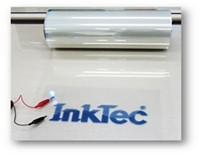Advertisement
Grab your lab coat. Let's get started
Welcome!
Welcome!
Create an account below to get 6 C&EN articles per month, receive newsletters and more - all free.
It seems this is your first time logging in online. Please enter the following information to continue.
As an ACS member you automatically get access to this site. All we need is few more details to create your reading experience.
Not you? Sign in with a different account.
Not you? Sign in with a different account.
ERROR 1
ERROR 1
ERROR 2
ERROR 2
ERROR 2
ERROR 2
ERROR 2
Password and Confirm password must match.
If you have an ACS member number, please enter it here so we can link this account to your membership. (optional)
ERROR 2
ACS values your privacy. By submitting your information, you are gaining access to C&EN and subscribing to our weekly newsletter. We use the information you provide to make your reading experience better, and we will never sell your data to third party members.
Materials
Flexible White Organic LEDs Achieve Record Efficiencies
Electronics: The devices use a new flexible, transparent electrode that performs better than electrodes in state-of-the-art LEDs
by Prachi Patel
December 19, 2014

Materials scientists have built large, flexible organic light-emitting diodes (OLEDs) that shine white light with record-high efficiency thanks to a new method for making transparent electrodes with silver networks (ACS Nano 2014, DOI: 10.1021/nn506034g). The new electrode is an important step toward practical OLEDs for roll-up displays and pliable lighting.
One challenge for achieving high-efficiency OLEDs is making flexible transparent electrodes. The brittle indium tin oxide (ITO) electrodes used in conventional glass devices cannot be used in bendable applications. So researchers have explored electrodes made of carbon nanotubes, graphene, and silver nanowires. Silver nanowires are especially promising because they are highly conductive. Researchers have sprayed or printed webs of the wires onto surfaces to build electrodes. However, the wires adhere weakly to these surfaces and to each other, which lowers the conductivity of the nanowire meshes. As a result, flexible OLEDs with these silver nanowire webs as electrodes have low efficiencies compared with ITO-based devices.
So Jian-Xin Tang and Yan-Qing Li of Soochow University, in China, and their colleagues decided not to work with mixtures of nanowires and instead came up with a quick, simple method to mold a fully connected silver wire network all at once right into a plastic film.
The team started with a plastic base topped with an uncured resin that they stamped with a piece of nickel patterned with a hexagonal network of ridges. Once the resin cured, the resulting film was covered with a hexagonal network of 3-µm-wide channels. The scientists filled the channels with silver nanoparticle ink, scraped off the excess silver, and sintered the film in an infrared oven at 100 °C for six minutes. The result was a silver wire lattice embedded into the resin.
Past efforts to get silver nanowires to stick to each other and the substrate have required high temperatures of around 200 °C. The new process relies on solutions and lower temperatures, making it more compatible with plastic substrates, Tang says. It could be adapted to roll-to-roll processing to make affordable devices on large-area plastic films. Currently, the researchers can embed silver lattices on large, 30-inch-diagonal plastic sheets.
The embedded silver electrodes are highly transparent, transmitting more than 88% of light hitting them. They also have a low electrical resistance of 4.7 ohms per square, which is better than the 15 to 20 ohms per square of other reported silver nanowire electrodes, or even ITO-based ones, Tang says.
The researchers used the embedded films as the anode in large, 50- by 50-mm bendable white and green OLEDs. The white OLEDs had a power efficiency that was at least twice as high as those of previously reported devices made with silver nanowires, Tang says.
Yang Yang, a materials scientist at the University of California, Los Angeles, says that so far the only OLEDs with such high efficiencies have been ITO-based devices on glass. The beauty of the new electrode-fabrication method lies in using well-known lithography techniques to make the embedded network. “I like this idea a lot,” he says. “It’s easy to control and is reproducible. It’s nothing fancy, but it works.”





Join the conversation
Contact the reporter
Submit a Letter to the Editor for publication
Engage with us on Twitter